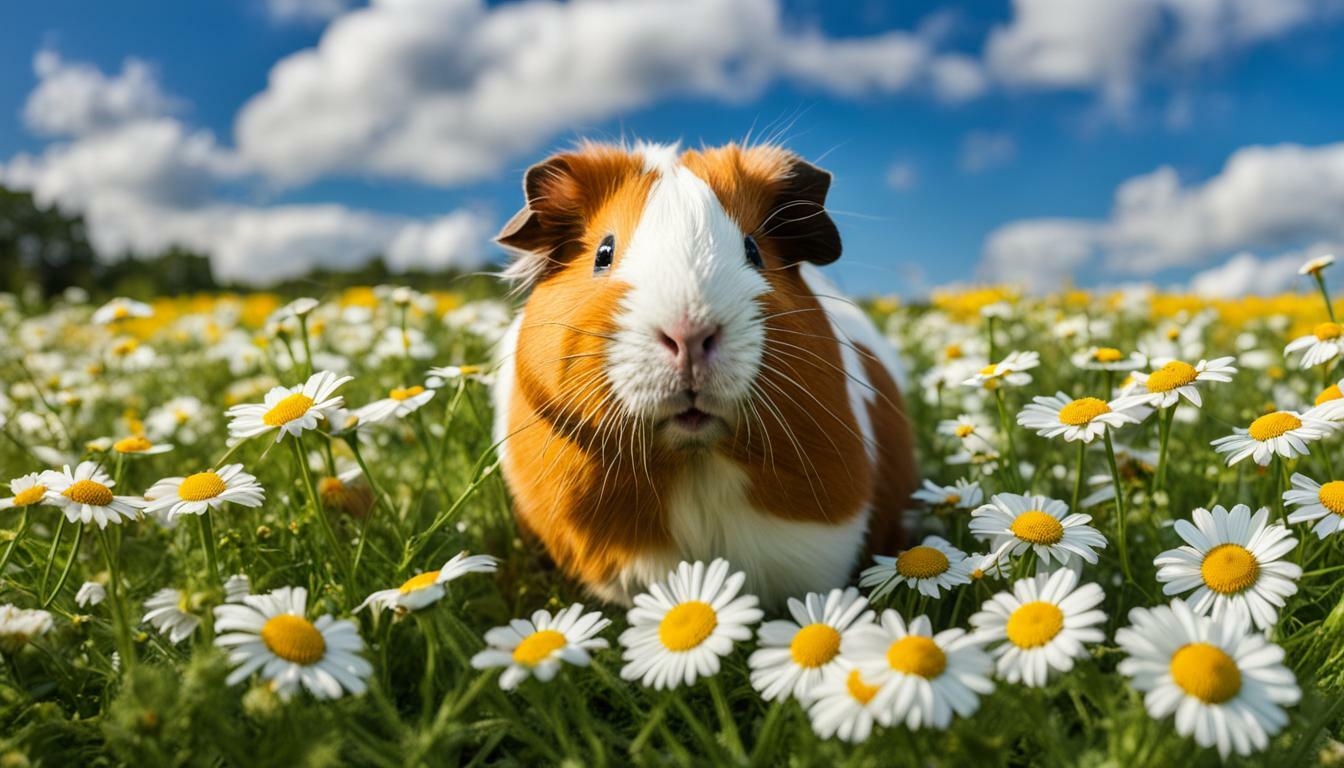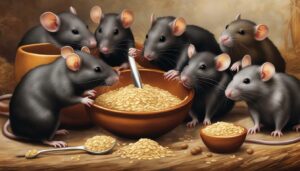If you’re wondering whether your guinea pig can enjoy the soothing benefits of chamomile, you’ve come to the right place! Chamomile is not only safe for guinea pigs to eat, but it also offers a range of health benefits for these adorable pets. Before incorporating chamomile into your guinea pig’s diet, it’s important to understand the nutritional value of this herb and how to feed it safely. Let’s dive into the world of chamomile and discover everything you need to know!
Key Takeaways:
- Guinea pigs can safely consume chamomile in moderation.
- Chamomile is nutritious and offers various health benefits for guinea pigs.
- Avoid chamomile that may contain pesticides or contaminants.
- Start with a small amount of chamomile and gradually increase to prevent digestive issues.
- Guinea pigs can eat fresh or dried chamomile flowers and stems, but not chamomile tea.
The Nutritional Value of Chamomile for Guinea Pigs
Chamomile is not only a delightful treat for your guinea pig but also comes with a range of nutritional benefits that can promote their overall well-being. This gentle flower is rich in antioxidants, which help protect your guinea pig’s cells from damage caused by harmful free radicals. The antioxidants found in chamomile can boost your guinea pig’s immune system and contribute to their overall health and vitality.
In addition to its antioxidant properties, chamomile also has calming effects. It contains certain compounds that can help reduce stress and anxiety in guinea pigs, promoting a sense of relaxation and well-being. This can be particularly beneficial for guinea pigs that may be prone to nervousness or agitation.
Chamomile is known to support digestive health in guinea pigs. It can help soothe the digestive system, alleviate inflammation, and ease digestive discomfort. This makes it a great addition to your guinea pig’s diet, especially if they have any digestive issues or sensitivities.
The Nutritional Value of Chamomile for Guinea Pigs
| Nutrient | Amount |
|---|---|
| Antioxidants | High |
| Calming properties | Yes |
| Digestive support | Yes |
It is important to note that while chamomile is safe for guinea pigs, moderation is key. Start by introducing small amounts of chamomile into your guinea pig’s diet and gradually increase the serving size. This will help their digestive system adjust and minimize the risk of any digestive issues.
Overall, chamomile can be a wonderful addition to your guinea pig’s diet, providing them with numerous health benefits. Remember to always source chamomile from reputable suppliers to ensure it’s free from pesticides or contaminants. By incorporating chamomile into your guinea pig’s diet 1 to 2 times a week, you can offer them a tasty and nutritious treat that supports their overall well-being.
Safe Consumption of Chamomile for Guinea Pigs
While chamomile is generally safe for guinea pigs, there are a few considerations to keep in mind to ensure their well-being. It’s important to avoid chamomile that may have pesticides or contaminants on it, as these can be harmful to your furry friends. Look for organic chamomile that is free from any chemical additives.
When introducing chamomile to your guinea pig’s diet, start with a small amount and observe their reaction. Some guinea pigs may have sensitive digestive systems, so it’s crucial to monitor any signs of discomfort or gastrointestinal issues. Slowly increase the amount of chamomile over time as you gauge their tolerance.
When feeding chamomile to your guinea pig, it is best to offer fresh or dried flowers and stems directly. Avoid giving them chamomile tea, as this is not recommended for guinea pigs. Chamomile tea can have a higher concentration of chamomile and may contain other ingredients that could be harmful to their health.
Chamomile Consumption Dos and Don’ts for Guinea Pigs:
- Do source organic chamomile to avoid pesticides and contaminants.
- Do start with a small amount and gradually increase to test your guinea pig’s tolerance.
- Do monitor your guinea pig’s digestion and overall health after introducing chamomile.
- Don’t give your guinea pig chamomile tea.
- Don’t overfeed chamomile to your guinea pig; moderation is key.
Remember, chamomile should be considered a treat and not a staple in your guinea pig’s diet. It can be offered 1 to 2 times a week as a supplement to their regular food. Consult with a veterinarian if you have any concerns or questions about feeding chamomile to your guinea pig. With proper sourcing and moderation, chamomile can be a delightful addition to their diet, providing them with some natural health benefits to enjoy.
| Do | Don’t |
|---|---|
| Source organic chamomile | Give chamomile tea |
| Start with a small amount | Overfeed chamomile |
| Monitor digestion and health |
Fresh or Dried Chamomile: Which is Better?
When it comes to feeding chamomile to your guinea pig, you may wonder whether fresh or dried chamomile is the better choice. Both forms of chamomile have their advantages, and it ultimately depends on your personal preferences and what is available to you.
Fresh chamomile offers a vibrant taste and aroma that your guinea pig may find enticing. It contains essential oils that are highly beneficial and may provide a more potent dose of nutrients. However, fresh chamomile has a shorter shelf life and may not be as readily available year-round.
Dried chamomile, on the other hand, is convenient and can be easily stored for longer periods. It retains most of the nutritional value of fresh chamomile and can be a great option when fresh chamomile is not accessible.
Whether you choose fresh or dried chamomile, always ensure that it is free from pesticides and contaminants. Introduce chamomile gradually into your guinea pig’s diet to avoid any potential digestive issues, starting with a small amount and increasing slowly. Remember, moderation is key, and chamomile can be included in your guinea pig’s diet 1 to 2 times a week as a tasty and nutritious treat.
Why Chamomile Tea is Not Recommended for Guinea Pigs
While chamomile tea may be a popular choice for humans, it’s best to avoid offering it to your furry guinea pig friend. Although chamomile itself is safe and beneficial for guinea pigs, the concentrated form of chamomile in tea can pose some risks and is not suitable for their delicate digestive systems.
Chamomile tea often contains additional additives, such as sugar or honey, which can be harmful to guinea pigs. These additives can lead to weight gain, tooth decay, and other health issues in these small animals. Additionally, chamomile tea may have a higher concentration of chamomile than what is recommended for guinea pigs, potentially causing digestive upset or even toxicity.
Instead of offering chamomile tea, it is best to stick to the natural form of chamomile, such as the flowers and stems. These can be fed in small amounts as a tasty treat for your guinea pig. Remember to always introduce new foods gradually and monitor your pet for any adverse reactions. If you have any concerns or questions, it is recommended to consult with a veterinarian who can provide specific guidance based on your guinea pig’s individual needs.
Risks and Precautions
It is important to be aware of the potential risks and take necessary precautions when feeding chamomile to your guinea pig. While chamomile is generally safe for guinea pigs, it is always important to ensure that the chamomile you offer is organic and free of pesticides or contaminants. Additionally, it’s crucial to avoid overfeeding chamomile and maintain a balanced diet for your furry friend.
| Potential Risks and Precautions | Guidelines |
|---|---|
| Chamomile tea | Avoid offering it to your guinea pig as it can contain additives and a higher concentration of chamomile than what is recommended. |
| Pesticides and contaminants | Choose organic chamomile to minimize the risk of exposure to harmful substances. |
| Overfeeding | Offer chamomile in moderation, about 1 to 2 times a week, to prevent digestive issues and maintain a balanced diet. |
By following these guidelines and using common sense, you can safely incorporate chamomile into your guinea pig’s diet and provide them with a delightful and nutritious treat.
Foraging Chamomile for Guinea Pigs
If you have access to chamomile growing in the wild, you may be wondering if it’s safe to gather some for your guinea pig. The good news is that chamomile can be a tasty addition to your furry friend’s diet. However, there are a few precautions to keep in mind when foraging chamomile for guinea pigs.
Firstly, it’s essential to properly identify the plant before harvesting. Chamomile has small, daisy-like flowers with white petals and yellow centers. Make sure you’re picking chamomile and not a similar-looking plant to avoid any potential health risks for your guinea pig.
Additionally, it’s crucial to gather chamomile in moderation. While guinea pigs can enjoy chamomile, it should be given in small amounts to prevent digestive issues. As a general guideline, feeding chamomile 1 to 2 times a week is safe and ensures your guinea pig receives a varied diet.
| Foraging Chamomile for Guinea Pigs |
|---|
| Properly identify the chamomile plant before harvesting |
| Gather chamomile in moderation, feeding 1 to 2 times a week |
Remember, while chamomile can be a delightful treat for your guinea pig, it’s essential to prioritize their overall well-being by offering a balanced diet. If you’re ever unsure about introducing a new food or have concerns about your guinea pig’s health, it’s always best to consult with a veterinarian for professional advice.
Incorporating Chamomile into a Guinea Pig’s Diet
Now that you know chamomile can be a delightful addition to your guinea pig’s diet, let’s explore how to include it in their daily meals. Chamomile is safe and nutritious for guinea pigs, providing them with a range of health benefits. Here are some tips on introducing chamomile into their diet:
1. Start Slow and in Small Quantities
When introducing chamomile to your guinea pig, it’s important to start with a small amount and gradually increase the quantity. This allows their digestive system to adjust and reduces the risk of any digestive issues. Begin by offering a small piece of fresh chamomile or a pinch of dried chamomile to see how your guinea pig responds.
2. Choose Organic and Pesticide-Free Chamomile
Ensure that the chamomile you offer your guinea pig is organic and free from any pesticides or contaminants. Organic chamomile is a safer option as it reduces the risk of exposure to harmful chemicals. It’s best to source chamomile from reputable sources or consider growing your own chamomile plant.
3. Variety is Key
While chamomile can be a tasty treat, it’s essential to remember that it should be part of a varied diet. Guinea pigs require a mix of fresh vegetables, fruits, and high-quality hay for optimal nutrition. Consider combining chamomile with other safe and nutritious foods like carrots, bell peppers, or leafy greens to provide a well-rounded meal for your furry friend.
| Safe Foods for Guinea Pigs | Food Restrictions |
|---|---|
|
|
Remember to always monitor your guinea pig’s reaction to chamomile and any other new food. If you notice any adverse effects like diarrhea, bloating, or changes in behavior, discontinue feeding chamomile and consult a veterinarian. With proper moderation and care, chamomile can be a delightful and nutritious addition to your guinea pig’s diet.
Monitoring Your Guinea Pig’s Reaction to Chamomile
As with any new food introduced into your guinea pig’s diet, it’s crucial to pay attention to their response to chamomile and monitor for any potential issues. While chamomile is generally safe and nutritious for guinea pigs, it’s important to be aware that individual guinea pigs may have different reactions to certain foods.
Start by offering a small amount of chamomile to your guinea pig and observe their behavior and digestion over the next few hours. Look for any signs of discomfort, such as decreased appetite, diarrhea, or changes in activity levels. If you notice any adverse reactions, discontinue feeding chamomile and consult with a veterinarian.
To track your guinea pig’s response to chamomile, keep a record of their overall health and any changes in their eating habits or stool consistency. This will help you identify any patterns or potential issues that may arise from consuming chamomile.
| Potential Signs of Adverse Reaction to Chamomile | Actions to Take |
|---|---|
| Decreased appetite | Remove chamomile from their diet and consult with a veterinarian if the issue persists. |
| Diarrhea or loose stools | Discontinue feeding chamomile and monitor their stool consistency. If the issue continues, seek veterinary advice. |
| Changes in behavior or activity levels | Observe their behavior closely and consult with a veterinarian if there are persistent changes. |
By closely monitoring your guinea pig’s reaction to chamomile and taking the appropriate actions if any issues arise, you can ensure their well-being and enjoy the benefits of this delightful herb in their diet.
Other Safe Treats for Guinea Pigs
While chamomile is a wonderful treat for guinea pigs, it’s always a good idea to have a variety of safe options to keep their taste buds satisfied. These furry friends enjoy a range of fruits and vegetables as part of a balanced diet. Here are some other safe treats that you can offer your guinea pig:
- Bell peppers: These colorful veggies are packed with Vitamin C, which is essential for guinea pigs. Offer small slices of red, green, or yellow bell peppers as a nutritious snack.
- Carrots: Carrots are another great option that guinea pigs love. They’re high in fiber and provide important nutrients like Vitamin A. Remember to only give small, bite-sized pieces to prevent choking hazards.
- Apples: Guinea pigs can enjoy small slices of apple as an occasional treat. Be sure to remove the seeds and core before offering it to your pet.
- Cucumbers: Refreshing and hydrating, cucumbers are a safe and crunchy snack for guinea pigs. Slice them into small pieces for easy munching.
- Leafy greens: Guinea pigs need leafy greens as part of their diet. Consider offering them spinach, kale, or romaine lettuce in small amounts.
Remember, moderation is key when it comes to feeding treats to guinea pigs. While these options are safe, they should be given in small portions to avoid digestive upset. Always consult with a veterinarian if you have any concerns about your guinea pig’s diet or if you notice any changes in their health. By providing a variety of safe treats, you can ensure both the satisfaction and well-being of your adorable guinea pig.
| Treat | Benefits |
|---|---|
| Bell peppers | High in Vitamin C |
| Carrots | Rich in fiber and Vitamin A |
| Apples | Source of essential nutrients |
| Cucumbers | Hydrating and crunchy |
| Leafy greens | Provide necessary vitamins and minerals |
Common Misconceptions about Feeding Chamomile to Guinea Pigs
There are a few misconceptions floating around when it comes to feeding chamomile to your guinea pig, and it’s essential to separate fact from fiction. Let’s address these misunderstandings and provide you with accurate information to ensure the well-being of your furry companion.
Misconception 1: Chamomile is toxic to guinea pigs. This is not true. In fact, chamomile is safe and can be a nutritious addition to your guinea pig’s diet. Just remember to introduce it gradually and in moderation to avoid any digestive issues.
Misconception 2: Guinea pigs can drink chamomile tea. This is incorrect. While guinea pigs can consume fresh or dried chamomile flowers and stems, chamomile tea is not recommended. The concentrated form of chamomile tea can be too strong for their delicate digestive system.
Misconception 3: You can feed chamomile to your guinea pig every day. Although chamomile is safe for guinea pigs, it should be given in moderation. A recommended frequency is 1 to 2 times a week, as part of a balanced diet that includes other safe foods for guinea pigs.
| Myth | Reality |
|---|---|
| Chamomile is toxic to guinea pigs. | Chamomile is safe and nutritious for guinea pigs when fed in moderation. |
| Guinea pigs can drink chamomile tea. | Chamomile tea is not recommended for guinea pigs; they can consume fresh or dried chamomile flowers and stems instead. |
| You can feed chamomile to your guinea pig every day. | Chamomile should be given 1 to 2 times a week as part of a balanced diet. |
By debunking these misconceptions, you can confidently offer your guinea pig the occasional treat of chamomile, knowing that it can provide nutritional and health benefits. Remember to observe your guinea pig’s reaction and consult with a veterinarian if any concerns arise. Enjoy exploring new flavors and keeping your guinea pig happy and healthy!
Potential Risks and Precautions
While chamomile is generally safe for guinea pigs, it’s crucial to be aware of any potential risks and take necessary precautions to ensure their well-being. Here are a few key points to keep in mind when feeding chamomile:
- Moderation is key: While chamomile is a healthy treat for guinea pigs, it should be fed in moderation. A small amount, around one to two times a week, is sufficient to provide the benefits without overwhelming their digestive system.
- Avoid pesticide exposure: It’s important to source chamomile that is free from pesticides or contaminants. These chemicals can be harmful to guinea pigs and may cause adverse reactions. Consider purchasing organic chamomile or growing your own chamomile plant.
- Start slow and monitor: When introducing chamomile to your guinea pig’s diet, start with a small amount and gradually increase the quantity. This helps their digestive system adjust and minimizes the risk of any digestive issues. Keep a close eye on your guinea pig’s behavior, digestion, and overall health to ensure they tolerate chamomile well.
While chamomile tea may be a soothing beverage for humans, it is not recommended for guinea pigs. The concentrated form of chamomile in tea can be too potent for their delicate systems, potentially leading to digestive upset or other adverse reactions. Stick to feeding chamomile flowers and stems directly, either fresh or dried.
| Chamomile for Guinea Pigs | Rating |
|---|---|
| Safe and Nutritious | ⭐⭐⭐⭐ |
| Moderation | ⭐⭐⭐⭐ |
| No pesticides or contaminants | ⭐⭐⭐ |
| Start slow and monitor | ⭐⭐⭐⭐ |
| Avoid chamomile tea | ⭐⭐⭐ |
By following these precautions, you can safely incorporate chamomile into your guinea pig’s diet and provide them with a tasty and nutritious treat. Remember, always consult with a veterinarian if you have any concerns or questions regarding your guinea pig’s diet.
Conclusion
Now that you have a comprehensive understanding of feeding chamomile to your guinea pig, you can confidently introduce this delightful herb into their diet while keeping their health and well-being in mind.
Chamomile is safe and nutritious for guinea pigs, offering a range of health benefits. Packed with antioxidants, it can help boost their immune system and protect their cells from damage. The calming properties of chamomile can also have a positive effect on their overall well-being, helping to reduce stress and anxiety.
When feeding chamomile to your guinea pig, it’s important to choose a high-quality source to avoid pesticides or contaminants. Start with a small amount and gradually increase the serving size to prevent any potential digestive issues. Fresh or dried chamomile flowers and stems can be given, but chamomile tea should be avoided as it is not suitable for guinea pigs.
Foraging chamomile in the wild can be a fun activity, but it’s crucial to properly identify the plant and only gather a small amount. Moderation is key, and incorporating chamomile into your guinea pig’s diet 1 to 2 times a week is recommended to ensure a well-balanced meal.
Overall, chamomile can be a tasty and beneficial treat for your guinea pig. By following these guidelines and monitoring their reactions, you can enhance their diet and provide them with a delightful and enriching culinary experience. So go ahead, introduce a bit of chamomile into your guinea pig’s life and watch them enjoy this gentle herb!
FAQ
Can guinea pigs eat chamomile?
Yes, guinea pigs can eat chamomile in moderation.
What are the nutritional benefits of chamomile for guinea pigs?
Chamomile is packed with antioxidants and has calming properties. It can support digestive health and improve eyesight in guinea pigs.
How should chamomile be fed to guinea pigs?
It is important to avoid chamomile that may have pesticides or contaminants. Start with a small amount and increase slowly to prevent digestive issues.
Can guinea pigs eat fresh or dried chamomile?
Guinea pigs can eat both fresh and dried chamomile flowers and stems.
Is it safe for guinea pigs to drink chamomile tea?
No, guinea pigs should not drink chamomile tea. It is best to stick to the direct consumption of chamomile flowers and stems.
Can chamomile be foraged in the wild for guinea pigs?
Chamomile can be foraged in the wild, but it is important to properly identify the plant and only harvest a small amount.
How often should chamomile be included in a guinea pig’s diet?
Chamomile can be included in a guinea pig’s diet 1 to 2 times a week.
What should I look out for when feeding chamomile to my guinea pig?
It is important to monitor your guinea pig’s behavior, digestion, and overall health to ensure that chamomile agrees with their system.
What are some other safe treats for guinea pigs?
Other safe treats for guinea pigs include vegetables, fruits, and herbs like parsley and cilantro.
Are there any risks or precautions associated with feeding chamomile to guinea pigs?
It is important to practice moderation, source chamomile from reliable sources, and consult with a veterinarian if any concerns arise.
Conclusion
In conclusion, guinea pigs can enjoy chamomile as a tasty treat 1 to 2 times a week. It provides nutritional benefits and can support their overall health, but it should be fed in moderation and proper precautions should be taken to ensure their well-being.




